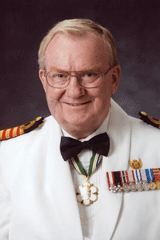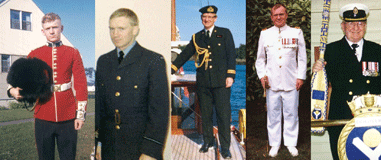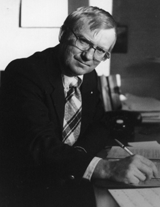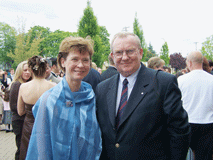Dr John Blatherwick—An appreciation
By the time Dr John Blatherwick retired in June, he had amassed a list of accomplishments and awards long enough to make the rest of us blush. His greatest accomplishment may be, however, that through his work, he made a lot of people a lot healthier.

When I started what would become a lifetime career in public health, in the early 1970s, at Vancouver’s Pine Street Youth Clinic, I was following in the footsteps of a man who became a mentor, a boss (briefly), an exemplar, and later a respected colleague. He is also the man who since the early 1980s in British Columbia is most associated in the media and in the public’s mind with the idea of public health.
Francis John Blatherwick has defined public health for a generation of British Columbians. Whether it was fighting the discrimination faced by AIDS sufferers and insisting on plain language and condoms for meaningful HIV education and prevention in 1984 (for which initiatives the premier of the day sought to fire him), opening one of Canada’s first needle and syringe exchanges in 1985, handling North America’s second-largest restaurant-associated botulism outbreak (26 cases) in 1985, protecting low-income housing against profiteering interests during Expo ’86, battling for rationality in contaminated lands clean-up criteria in 1988, leading the Greater Vancouver Water District to improve upon drinking water safety, mounting a multi-year campaign against exposure to tobacco smoke, or launching new childhood vaccine programs, John was the face and the voice that the public, the media, and the politicians learned to listen to and listen for.
John also entered public health through the doors of Kitsilano’s Pine Street Youth Clinic in 1971. He was, in fact, instrumental in starting this clinic in the hippy era of pot smokers, free love, and draft dodgers. It may have seemed a strange choice for the son of a military family who was at that time doing a residency in internal medicine at Vancouver General Hospital and who by his own account was straight as an arrow. The logic, however, of intervening upstream to prevent problems or catch them before they became severe led him to a subsequent 1975 diploma in public health and a fellowship in the Royal College of Physicians of Canada (FRCPC), specialty in public health in 1976.
He served as the medical health officer in Coquitlam (Simon Fraser Health Unit) from 1976 to 1984. During this time he was training residents in community medicine through the Department of Health Care and Epidemiology at UBC, he was on the Board of Examiners of the Royal College of Physicians and Surgeons of Canada, and he was chair of the Provincial Child Care Licensing Board.
In 1984 he was appointed medical health officer for the City of Vancouver and promptly hit the front pages, where as he says, “I fought AIDS (and the provincial government of the day) in the front pages of the newspapers… trying to get the message out.”
He never looked back. He retired from his position as chief medical health officer for Vancouver Coastal Health 23 years later in June 2007. He worked with two mayors who later became provincial premiers and one who went on to become a senator. He helped cement the dictum that municipalities have a critical role to play in both protecting and promoting the health of their publics. Working with Philip Owen, Vancouver’s longest-serving mayor, he helped set the stage for the opening of North America’s first (and so far only) supervised injection site, Insite, as a scientific-medical pilot project. Working with the city’s present mayor, John sat on the medical advisory board of the Chronic Addiction Substitution Trial (CAST). Another innovative initiative aimed at combating the public health threats of substance abuse, mental health, homelessness, and bloodborne diseases.
John has also written more than 20 books, mostly on honors, decorations, medals, and airplanes. Most recently, two volumes have celebrated the world of public health in BC and Vancouver and have paid a special tribute to the often unsung heroes, environmental health officers.
He is the recipient of an impressive set of awards including the Order of Canada in 1994 for his work in public health and the Queen’s Golden Jubilee Medal in 2002. He was named Canadian Health Hero by the Pan American Health Organization in 2002. He received the Silver Medal of Service from the BCMA in 2005, and the Order of British Columbia in 2007, again in recognition of his work in public health.
John also served for 39 years in the Canadian Forces Reserves, retiring in 2000 with the rank of commander and the position of senior naval reserve medical advisor. He represented Canada from 1989 to 1995 at NATO as the head of the Canadian Forces Reserve Medical Group.
John has been long married to Carol, a general practitioner in Surrey and, according to his four children, a “real doctor.” Wikipedia also notes that he is a “scrappy” hockey player.
I have known him as a highly respected public health physician, a mentor and a leader, a man who always spoke truth to power (usually clearly and succinctly), a supporter of the discipline, art, and science of public health, a worthy descendant of Rudolph Virchow and Charles Hastings, a superb communicator, and a respected colleague.
Acknowledgment
Thanks to Dr Shaun Peck, previous deputy provincial health officer, for input.

A distinguished military career (L-R): Governor General's foot guards, RCAF, Navy green uniform, Navy whites, and finally retirement in Navy Blue.

Dr Blatherwick as known to city of Vancouver residents.

Take-off in the Harvard from the Museum of Flight, Langley.

Pictured here with wife, Dr Carol Blatherwick.
